
Acinonyx is a genus within the Felidae family. The only living species of the genus, the cheetah, lives in open grasslands of Africa and Asia.

Latastia is a genus of lizards of the family Lacertidae. Species of this genus are distributed in Africa but one subspecies lives in Yemen. Collectively, they are known as long-tailed lizards.

Paul Jakob Deussen was a German Indologist and professor of philosophy at University of Kiel. Strongly influenced by Arthur Schopenhauer, Deussen was a friend of Friedrich Nietzsche and Swami Vivekananda. In 1911, he founded the Schopenhauer Society (Schopenhauer-Gesellschaft). Professor Deussen was the first editor, in 1912, of the scholarly journal Schopenhauer Yearbook (Schopenhauer-Jahrbuch).
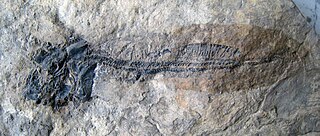
Ctenurella is an extinct genus of ptyctodont placoderm from the Late Devonian of Germany. The first fossils were found in the Strunde valley in the Paffrather Kalkmulde.

Kaestlea travancorica, also known as the Travancore ground skink or Barbour's ground skink, is a species of skink endemic to southern Western Ghats.
Sphenomorphus courcyanus is a species of skink found in Asia.
Albisaurus was once thought to be a genus of dinosaur, but is now thought to be a non-dinosaurian archosaur. It was first described by Antonin Fritsch, a Czech palaeontologist, in 1893, but the remains are sparse. The validity of the species cannot be proven based on the fossil remains, and it is usually marked as a nomen dubium. It lived during the Turonian-Santonian stages of the Cretaceous period.

Cretornis is a pterosaur genus from the late Cretaceous period of what is now the Jizera Formation in the Czech Republic, dating to about 92 million years ago. It only contains a single species, Cretornis hlavaci.

Manouria is a genus of tortoises in the family Testudinidae. The genus was erected by John Edward Gray in 1854.
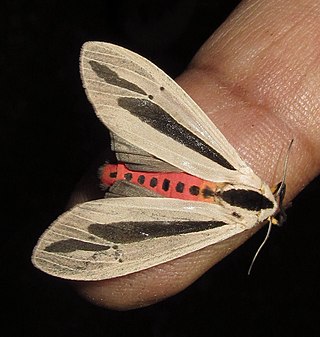
Creatonotos is a genus of tiger moths in the family Erebidae. The moths in the genus are found in the Afrotropics, South and East Asia, Sundaland and Australia.
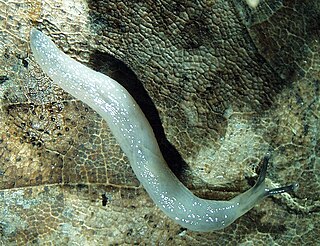
Boettgerilla is a genus of air-breathing land slugs, terrestrial pulmonate gastropod molluscs in the family Boettgerillidae.
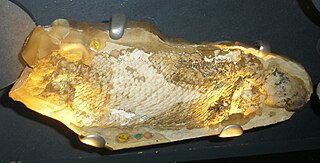
Chirodipterus is an extinct genus of marine lungfish which lived during the Devonian period. Fossils have been found worldwide, including Germany, China, eastern & western Australia, and the United States (Michigan). However, it has been suggested that the genus as currently defined is polyphyletic, in which case only the German type species would belong to the genus.
Denazinosuchus is a genus of goniopholidid mesoeucrocodylian. Its fossils have been recovered from the Upper Cretaceous Fruitland Formation and Kirtland Formation of the San Juan Basin, New Mexico. It is the most abundant and readily identifiable mesoeucrocodylian of the San Juan Basin, mostly due to its distinctive subrectangular, flattened, and sparsely pitted bony armor. It was first described in 1932 by Carl Wiman on the basis of a skull as a species of Goniopholis, G. kirtlandicus. Spencer G. Lucas and Robert M. Sullivan redescribed the species in 2003 and gave it its own genus, Denazinosuchus. To date, Denazinosuchus is only known from skull material, armor, and a thigh bone.
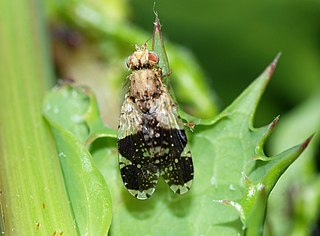
Tephritis is a genus of flies. It contains around 170 described species, making it the sixth largest genus in the family Tephritidae. Many more undescribed species are known from specimen collections. Tephritis occur throughout much of the world, but most are Palearctic. They can be found in a wide range of climate types, from hot semidesert to tundra. Most species inhabit the inflorescences of plants from several tribes in the family Asteraceae, and a few species cause galls to form.

Ligulalepis is an extinct genus of stem-osteichthyans which lived from the Silurian to the Early Devonian. Ligulalepis was first described from isolated scales found in the Taemas-Wee jasper limestones of New South Wales by Hans-Peter Schultze (1968) and further material described by Burrow (1994). A nearly complete skull found in the same general location was described in Nature by Basden et al. (2000) claiming the genus was closely related to basal ray-finned fishes (Actinopterygii). In 2015 Flinders University student Benedict King found a more complete new skull of this genus which was formally described by Clement et al. (2018), showing Ligulalepis to be on the stem of all osteichthyans.

Jackdaws are two species of bird in the genus Coloeus closely related to, but generally smaller than, crows and ravens (Corvus). They have a blackish crown, wings, and tail, with the rest of their plumage paler. The word Coloeus is Neo-Latin, from the Ancient Greek for jackdaws: koloiós (κολοιός). They come from Asia, Europe, Africa and Siberia.
Francosuchus is a dubious genus of probably basal phytosaur known from the Late Triassic of Bavaria, southern Germany. It was named by Oskar Kuhn in 1933 and the type species is Francosuchus broilii. In the same article Kuhn also named a second species Francosuchus latus. Both species were known solely from their holotypes, two partial skulls that were housed at the Bavarian State Collection for Palaeontogy and Geology. Both specimens were collected at Ebrach Quarry, bed number 13 from the late Carnian-aged Blasensandstein Member of the Hassberge Formation. As the holotypes were destroyed during World War II and poorly documented, Francosuchus and its species are usually considered to be nomina dubia.
Chelonides is a genus of late Jurassic turtle from marine deposits in Lower Saxony, Germany.
Buhoma is a genus of snakes in the superfamily Elapoidea. The genus is endemic to Africa.

Bohemiclavulus is a genus of synapsids that was discovered in the Slaný Formation of the Czech Republic. The type, and currently only, species is B. mirabilis.













